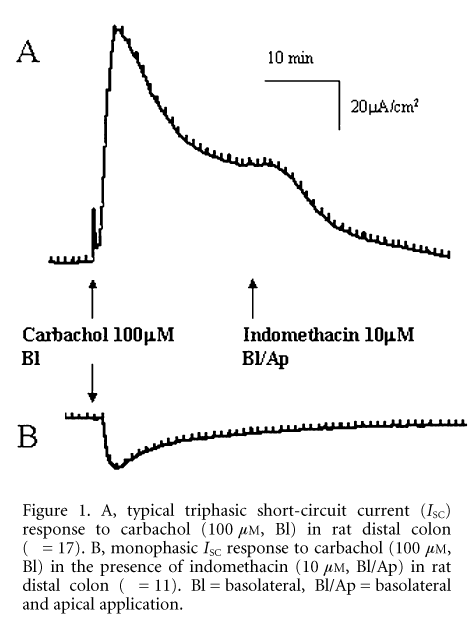The muscarinic receptor agonist carbachol is believed to evoke Cl– secretion in rat colonic epithelial cells by elevation of intracellular Ca2+ (Greger et al. 1997) and although Ca2+-activated Cl– channels have been identified in colonic epithelial cell lines (Merlin et al. 1998) controversy exists over their presence/function in native colonic epithelia. Previous studies from this laboratory have shown that carbachol evokes Cl– and HCO3– secretion in rat distal colon (Bellingham et al. 2002). Here we have examined the effects of both cAMP- and Ca2+-activated Cl– channel inhibitors on carbachol-evoked anion secretion in rat distal colon.
The terminal colon (5 cm) was removed from male Wistar rats killed by cervical dislocation. The mucosal portion was mounted in an Ussing chamber (area 0.5 cm2) containing Krebs solution (mM: NaCl 119, KCl 4.7, NaHCO3 24.8, MgSO4 1.2, KH2PO4 1.2, CaCl2 2.5 and glucose 11.1) at 37 °C, gassed with 95 % O2 and 5 % CO2. Short-circuit current (ISC) was recorded and measurements were taken from baseline to peak. All values represent means ± S.E.M. and Student’s unpaired t test was used to test significance (P < 0.05).
Basal ISC was 18.4 ± 5.2 mA cm-2 with a resistance of 102.3 ± 6.8 Ω cm-2 (n = 17). Enhancing cAMP levels by adding the phosphodiesterase inhibitor isobutylmethylxanthine (IBMX, 100 mM basolaterally) increased ISC by 45.0 ± 12.1 mA cm-2 (n = 3), suggesting tonic activation of cAMP-sensitive channels. Addition of the CFTR channel blocker diphenylamine-2-carboxylic acid (DPC, 100 mM apically) reduced basal ISC by 9.9 ± 4.0 mA cm-2 (n = 3), whereas addition of the Ca2+-activated Cl– channel inhibitor 4,4-diisothiocyanatostilbene-2,2-disulfonic acid (DIDS, 1 mM apically) had no effect on basal ISC (n = 4). Furthermore, in the presence of DPC (100 mM apically) all three phases of the typical carbachol response (Fig. 1A) were significantly attenuated (P < 0.05, n = 3). However, in the presence of DIDS, carbachol-evoked ISC was not significantly different from control (n = 4). Inhibition of endogenous cAMP production via the prostaglandin pathway, with the cyclo-oxygenase inhibitor indomethacin (10 mM basolaterally and apically), resulted in a markedly altered carbachol response (Fig. 1B, n = 11). Under these conditions, carbachol evoked a decrease in ISC (-5.7 ± 2.5 mA cm-2, n = 11).
The present results suggest that CFTR is the predominant Cl– channel involved in carbachol-evoked anion secretion in the rat distal colon. These results support the findings of Strabel & Diener (1995) and provide further evidence against direct activation of Cl– channels by carbachol in rat distal colon.
All procedures accord with current UK legislation.

